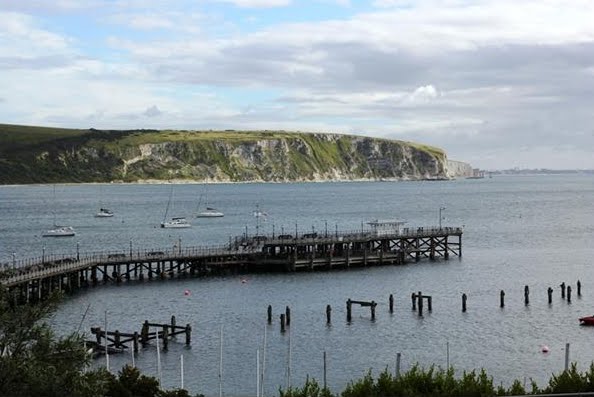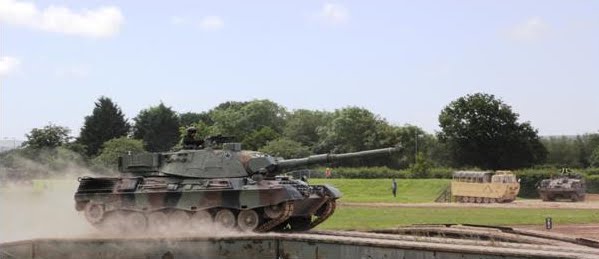Heading for the Country
“One, two, three, four … On the road again, just can’t wait to get on the road again, goin’ places that I’ve never been, seein’ things that I may never see again, just can’t wait to get on the road again.”
It is six o’clock. AM! It is already light, the road ahead is clear, the wipers are a-tangoing in the rain, the radio that is my head, is blaring and I am thumping the steering wheel with my hands. Just me, and Willie, and my dominatrix, Jane, “Cross the roundabout, second exit.” I’m leaving Southampton, heading for the M27, then the A31, and my favourite county, Dorset. Yo, Willie boy, life is good, “On the road again …”
Oh I do love the English countryside, those rolling hills, the vales where the land breathes in, all is lush and green, the blue of the fields of flax, the yellow of ripening wheat, the tilled brown soil of rich tomorrows, rabbits darting from the thicket and back again, a distant copse, a phalanx of woods, the glimpse of a great house, the glistening of a stream. Hallelujah! Only the speed restrictions to prevent abandon. After the city, any city, the countryside brings release, like the tossing off of a heavy garment.

The River Frome at Wareham; Ducks on guard while the swans sleep!
In an hour, I am in Wareham. Willie still crooning too, and I didn’t have the heart to tell him that I have been here before, with good friends, in the rain. It was the beauty of the place which has drawn me back for Wareham has a rich history as a place of some solidity amid the marshes, between the rivers Frome and the hilariously named, Piddle. It can trace settlement back to the Neolithic age and has Kings Alfred and the King of Denmark, England and bits of Sweden, old Canute, within its pedigree. Indeed Canute, with all the zeal of Sarah Lund, sacked the town in 1015, and after the C17 Monmouth rebellion against King James II failed, Judge Jeffries of “Bloody Assizes” fame, had a number of Monmouth’s supporters drawn and quartered (Which was probably a swifter death than Monmouth’s own death at the Tower of London, when the axe-man needed six or eight chops!) Much of the town was subsequently destroyed in a fire, but it now rests peacefully as a place full of Georgian architecture.
The main street slept as I drove through, so I made my way to the ancient stone quay from where Danish long-ships, long ago, had voyaged with oar and sail for Poole, the North Sea, and home-coming in Copenhagen. Then they would have been low in the water, full of grain and hides. Now not a soul stirred as I walked the river bank to take a photo, and the only sound was the rumble of the occasional car going over the bridge. A little further up the Frome, a family of swans were still tucked up in bed although a hissing sound, like opening a can of Carlsberg, came from somewhere in a feathery bundle, and I backed off and away.
Corfe Castle appears suddenly on a limestone ridge, like a dragon pushing up out of the undergrowth, the lumps on its scaley back, weathered by age and conflict. I didn’t have the heart to tell Willie I had been there too. In 1987, my two sons had rolled down the castle slopes like spent cannonballs, while a score year later we had a memorable lunch at The Greyhound Inn, with our friends from Bahrain. Historic, still picturesque, with a grey stone village nestled to its castle bosom, the whole area has been given over to the National Trust, and it is one of their showpiece establishments

The ruins of Corfe Castle on its pimple, commanding the surrounding countryside.
Corfe Castle was one of the early castles built by William the Conqueror – well not personally, they had surfies to do those things in those days – and it is one of the first stone castles constructed in England. During the English Civil War, it was a Royalist stronghold and as her husband was at the side of his King, Lady Mary Banks and five loyalists held off the Parliamentary forces in an early siege in 1645. Later in the year, more Royalists were able to join Lady Mary in the castle but alas, one of her dirty dog soldiers betrayed her, and the place was overrun by Cromwell’s Roundheads (As the Parliamentary forces were called – probably Flatheads these days!). Under Parliamentary ruling, the castle was to be ‘slighted’ – a quaint old English word for ‘destroyed,’ and it was blown up to leave it in the attractive higgledy piggledy manner, seen today.
Here too, it was quiet and my footfall echoed from the cobbles and the walls of the stone houses. I could only imagine – as little boys still do – the roar of cannon and the ribald taunts from the barricades. I wandered to the little railway station and saw a railway volunteer readying things for the steam train running for tourists on the weekend. I would have loved to see the spectacle of black smoke rising from the valley and giving a siege look to the castle, but already seagulls were mewing overhead, the call to the coast, and besides, nothing on the Square was as yet open for breakfast. My stomach was now in its own state of siege. I hurried on.

The Corfe Castle railway station and the ruins of the castle
The road to the coastal town of Swanage was over hills and through leafy dales with crows busy on the roads, plucking at bouncy-bunnies-no-more. The sea sparkled in the much appreciated sunshine, and the green headland to the chalk cliffs at Studland looked as geometrically divided by hedge-rows as a mint-green Battenberg cake, with white sheep and cattle strewn in paddocks, like hundreds-and-thousands. If I were a Martian beaming my way to earth, the area around Swanage looked like a nice comfy place on which to land.
I’d been to Swanage before (Don’t tell Willie!) and liked its setting, protected in the lee of a crooked finger of headland, with a sort of fishing village atmosphere and as minor port, I could imagine the bawdy shanties late at night at closing time. With the coming of the railway in 1885, Swanage became a destination for holidaying Victorians drawn to its sandy beaches and clear waters, much as divers are today, drawn by the prospect of exploring coastal wrecks. I saw many dressed as seals, making for the famous Pier, lugging aqua-lungs. A large banner proudly proclaimed that the Swanage Pier was a “Finalist in the Pier of the Year competition.” All those judges, swaning around those piers, from one end of England to another, even the piers that appeared to have little chance of making it to the final of Strictly For Prancing.

Looking towards Studland beyond the Swanage Pier
I had the Full English Breakfast at The Seagull, a hole-in-the-wall caravan type structure beside a little park, with a fine view across Swanage bay. I am not sure whether my breakfast was already one earlier consumed by a seagull, but it sure looked and tasted that way. I found a place that sold Kit-Kats, and that took the taste away. It was time to get on the road again, particularly as the sky was blue, and clouds were few.
Indeed, this time, and no doubt to Willie’s delight, I was on a road I had never seen before, following the signs to Camp Bovington and Tankfest, the annual gathering of tanker aficionados held, at the British Army’s Tank school. And the closer I got, the more prevalent were the signs “Beware of tracked vehicles.” I looked ahead of me, and behind in the rear vision mirror, but then a 65 tonne Challenger, with a hurdy great gun coming out of its forehead, should be pretty hard to miss! And so were the hundreds of enthusiasts cars, parked with military precision on the rugger pitches.
Tankfest was created to allow the Tank Museum to show to the public, its ‘running vehicle fleet’ and each year there are opportunities to see former combat tanks ‘on the roll,’ with all the noise and dust to go with it.
First I made my way into the Tank arena, a vast viewing area not unlike a football stadium – past a tented lane of ‘camp followers’ selling every kind of military model, apparel and regalia, to an enthusiastic public. Beyond them, were the re-enactment groups, young and not so young men, kitted out in uniform and encamped as they would be in conflict, fox-holes and trenches dug, rifles and machine guns pointing outwards, as at Spionkop, Pozieres or in the Ardennes. Even the Boche were encamped, coalscuttle helmets and potato mashers! Here and there, ‘old soldiers’ wandered, often accompanied by a ‘caring nurse’ also in the kit of the time. I was amazed at the authenticity of the kit, rifles and pistols to be sure, but medical kits and ration packs! These folks sure were fans.

Spot the Leopard at speed!
I watched a WWII Tiger tank, captured intact in Tunisia when its crew ran away, maneuvered into position for a later runabout, but then all the big cats were there, a Panther and a pair of Leopards provided by the Canadian Army. The whole project is run by volunteer, who like their rail and air counterparts, badger governments for assistance and spend hours helping to restore old vehicles so that old codgers like me, can see them ‘in the flesh,’ not as static models but as an amalgam of working parts.
The museum is a gem with tanks from an original WWI Mark II, and its ‘Mark IV mate’ which was purposely built for the movie War Horse, to the tanks that fought in Iraq. There are British, German, Russian, Chinese, tanks all here, well displayed with excellent explanations of performance, and their combat history. I wandered around the exhibits wondering who would be the more frightened in combat, the soldiers who heard the coming of the roaring engine, the clank and squeak of the tank tracks, and fell under the range of the Leviathan’s guns, or the Tankers in their fetid steel coffins, with only tiny doors and hatches to escape a ‘brew-up,’ if struck by a shell. Like landed submariners, I thought. Neither scenario gave me much comfort.
Alas, I only had time to see some Leopards leaping and some APC’s ‘jamming’ to music a-la-synchronized swimmers, in the main arena, because I needed to be back in Southampton for a lunch at the nearby Robin Hood pub in Durley. Ah that Robin, he was surely a tanker of his time, with a posse of Merry Men, bounding out of the brush! I therefore missed many of the main performers, the Panzers and the Shermans, the Grants and the Stuarts, the Centurions and the Chieftains. There was to be a WWI battle re-enactment featuring tanks (of course), infantry and aerial dogfights above the battlefield, but my time had run out. I left the arena with the Camp Bovington soldiers guiding my little Vauxhall out of parking lot as though I had just gunned up The Black Prince.
I hit the road again, but this time it was John Denver in my head. “Take me home, country roads,” and as in the morning, I was right on song, and home indeed, in time for lunch!
Winfred Peppinck is the Tales of the Traveling Editor for Wandering Educators
All photos courtesy and copyright Winfred Peppinck




















